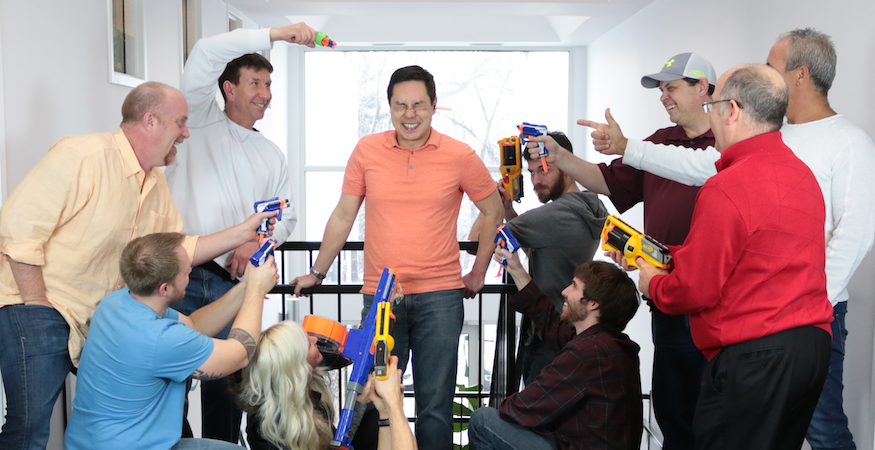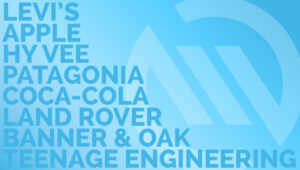For the last three months, our team has enjoyed the company of the “the world’s oldest intern,” Mr. Jim Wolf. As a Design, Interactivity & Media Arts instructor at Metropolitan Community College, Jim pursued a professional sabbatical to further his industry experience and bring that knowledge back to the classroom to better prepare his students for their own careers. Here’s a follow-up to our previous Q&A with Jim about what he learned during his time with us at Corporate Three Design.
Describe some of the advantages or disadvantages of working at a small(er) creative agency.
A small(er) studio really does feel like a family. And as we can all relate, we have some really great feelings about the idea of “family”… and we also know that every family has a unique, quirky nature 🙂
In this environment, it’s very important that everyone gets along. When hiring new employees, an agency must consider how well different personalities will fit together. If you had to pick a group of people to spend 40+ hours a week with, in close quarters, who would you choose?
Equally important is having employees with complementary skillsets. At C3D, I was impressed at the variety of creative skills each person brought to the table. I’d also like to give a shout out to the account management and business staff… there’s just as much diversity of skill and experience there as on the creative side. Both are equally important for a studio to thrive, because, with a smallish studio, each person’s contributions have a large impact on the end product.
You’ve worked in a design studio before, what are some of the biggest changes you’ve noticed regarding client relations and expectations? Has it changed at all?
From that perspective, it doesn’t seem that different. Clients are asking for more online work than print, but the client-studio relationship is almost identical to what is was when I worked as a full-time designer & account manager.
Studios need to understand their clients’ business forward and backward. A relationship that feels more like a long-term partnership is ideal, as opposed to the idea that studios are just vendors, not partners.
Are there any noticeable changes to the corporate structure of creative agencies that also affect the way we approach web design? Departments or jobs that didn’t exist before?
When looking through the lens of web design, there are dramatic differences in my mind. At my last design job, we did some web-related work, but mostly helping clients maintain existing sites, or providing graphic assets for their internal web person. We didn’t have a web developer on staff. Back then, I can’t remember ever meeting anyone who called themselves a “web developer” (we still used the term “webmaster”, which seems so antiquated to me now).
I pretty much expected that to be the case, but what surprised me was to learn that Corporate Three Design has a full-time content strategist. That’s a term I only became aware of in the last year or two, and C3D’s content strategist is only the second person I’ve met with that title.
I’m kind of curious about that job, because I come from a generation of designers where the idea of “designer as author” was making a comeback, but it was on the fringes of the profession. To me, the idea that design studios not only help clients shape their content, but also generate their own, is almost as dramatic a change as the rapid expansion of web-based projects.
Has your appreciation and understanding for modern, mobile-friendly web design changed or grown since you started working here? In what ways?
I’ve been reading articles and looking at mobile-use statistics for a few years now, but working at C3D made all that theory snap into focus. When I heard the lead developer explain his mobile-first development approach, it drew a sharp contrast between how developers think, and how most graphic designers work (on a mega large display).
It really threw me when I first opened the Photoshop template for mobile view… it seemed so tiny! But then I did what any good designer does (I hope)… I viewed my mobile layouts on both a smart phone and tablet, to see how they actually worked in context (or didn’t). Over time, I think I became better at seeing the mobile views as “normal” even though I was used to working on a much larger screen.
How did it feel to be on the opposite end of the teacher-student spectrum and receive art direction again on a regular basis?
I’ll admit that this was perhaps more challenging than I thought it would be. I didn’t realize it, but over the last decade of teaching, I got used to hearing constructive criticism less frequently. That’s not to imply teachers aren’t assessed at MCC; we are, by both our supervisors and our students, just not on a daily basis.
In a studio environment, the feedback is quick, immediate and specific. In academia, there’s a bit of lag between the work you do and receiving feedback on it. The are good reasons why that’s the way it works in academia; it’s too lengthy to go into here, but suffice to say, there are good reasons for that.
How will it influence the manner in which you give criticism to your students in the classroom?
I’ll be honest and say I’m not sure. On the one hand, my time at C3D has highlighted how different a classroom can be from the working world. One is more theoretical, the other practical. Does that mean I’ll go back to the classroom and “tell it like it is”? Well… maybe.
I hesitate because while I don’t believe in coddling students, I think there’s a bit of a danger in being extremely critical with someone who’s just learning something for the first time. Let’s be honest: the first time the majority of designers had to design something for a school project, it wasn’t professional level work that could be shown to a real-world client. It was the first time ever! Are you going to give the same feedback (both in tone, as well as content) that a client or creative director would give?
Well, maybe teachers should, since that’s the environment that most students want to end up in. Or maybe it would discourage students, because they didn’t do something perfectly their first time.
Describe one major thing you learned about design that you either didn’t already know or didn’t think still applied today.
What threw me at first was the misconception that web design is vastly different than print design. Now, I know that some designers will read that and their faces will turn purple, as they scream “web design is not simply translating a brochure into a website!” (take a deep breath, I know it isn’t).
Overall, the web is a vastly different medium than print, and for many reasons. But, the common element between web and print design is: people. How viewers respond to things like hierarchy, color, etc. on a digital device isn’t so different that I couldn’t use what I learned as a print-based designer. I just needed to expand and adapt it to encompass what makes the web different from print.
How will your time spent at C3D translate into a better learning experience for your students?
Teaching at a two-year institution, I’ve always felt that MCC takes more of an applied approach to learning, versus purely theoretical. Working at C3D has reminded me of what the working world is (and is not), and will help me make sure that the educational approach in my academic program doesn’t drift too far from the way design skills are applied in the workplace.
Name three specific ways you plan to better prepare your students for the very work environment you have experienced here over the last few months.
1) Have students think more deeply about content: We always explain to students that successful design starts with a strong concept, and the concept in turn, is set by the main message, target audience, and desired communication outcome. But I think there’s room for students to spend more time considering how content affects design; to better understand the relationship between the raw content and visual / verbal expression of that content.
2) Expose students to web design in as many classes as possible, not just the “official” web design courses: I’ll be curious to see if, in 10 years, we still have the term “web design”. I think that students entering today’s job market are going to be asked to design a variety of things, for a variety of media, and curricula that maintains a rigid distinction between print and web isn’t going to serve students as well as a blended approach. For example, when teaching typography, we talk about the difference between display and text type… why not add web type to the discussion?
3) Improve students’ Photoshop skills: Today’s design students have a quirky relationship with Photoshop; on one hand, most college students seem the most familiar with it compared to the other popular design programs (you never hear Illustrator or InDesign mentioned in popular culture). But when I think about how my Photoshop skills helped me at C3D, I began thinking “can the majority of our students do what I had to, on their first day of work”? Maybe 🙂 But I think there’s room to expand on that skill set.
Name one unexpected outcome that you experienced as a result of your time here at Corporate Three Design.
Whenever we make major life decisions, I think it’s rare that we get to compare and contrast that choice with an alternate version of reality, as if we’d never made that choice. I’ve wondered from time to time, if leaving professional practice to be a full-time educator was the right choice for me.
The purpose behind working at C3D during my sabbatical wasn’t to test my choice to leave professional practice; nonetheless, it reminded me how rewarding it can be to produce creative work that helps clients achieve their goals. But I missed teaching more than I thought I would.
For the past 3 months, I’ve wondered how the students are doing, how they were handling their classes this quarter, etc. I realized that teaching students skills that help them explore their passion for design, and that could lead to a life-long career, gives me a sense of accomplishment that I didn’t know I’d feel when I first started teaching.
In four words describe the work environment at C3D.
Intensely Dynamic Multiplex (of) Fun.
Using a four letter word, describe the staff at C3D.
Much 🙂
Anything else you would like to add?
Yes! I would like to express my extreme gratitude to everyone at Corporate Three Design for allowing me to work along side them for the past 3 months.
C3D could have found a “typical” intern, that might have taken less effort to manage, but you said yes to my request… along with having me ask a billion questions about web design and other topics. I’m very thankful for a community partner like C3D, who is willing to help a teacher and by extension, the students at my school, by sharing the wealth of knowledge and experience that makes C3D a great design studio. I feel very privileged to have worked with the talented, smart and joyful people that make C3D such a vibrant part of our professional creative community.
Do you want access to more behind-the-scenes content like this? Subscribe to our C3D email newsletter for a bimonthly installment of marketing news, business tips, music playlists, and full-length tutorials delivered right to your inbox!

